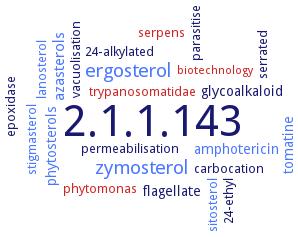2.1.1.143: 24-methylenesterol C-methyltransferase
This is an abbreviated version!
For detailed information about 24-methylenesterol C-methyltransferase, go to the full flat file.

Word Map on EC 2.1.1.143 
-
2.1.1.143
-
ergosterol
-
zymosterol
-
azasterols
-
flagellate
-
tomatine
-
amphotericin
-
phytosterols
-
glycoalkaloid
-
24-alkylated
-
lanosterol
-
phytomonas
-
vacuolisation
-
epoxidase
-
serpens
-
24-ethyl
-
permeabilisation
-
serrated
-
stigmasterol
-
trypanosomatidae
-
sitosterol
-
parasitise
-
carbocation
-
biotechnology
- 2.1.1.143
- ergosterol
- zymosterol
- azasterols
-
flagellate
- tomatine
- amphotericin
- phytosterols
-
glycoalkaloid
-
24-alkylated
- lanosterol
- phytomonas
-
vacuolisation
-
epoxidase
- serpens
-
24-ethyl
-
permeabilisation
-
serrated
- stigmasterol
- trypanosomatidae
- sitosterol
-
parasitise
-
carbocation
- biotechnology
Reaction
Synonyms
(S)-adenosyl-L-methionine-DELTA24-sterol methyltransferase, (S)-adenosyl-L-methionine:DELTA24(25)-sterol methyltransferase, 24-methylenelophenol C-241-methyltransferase, 24-sterol methyltransferase, C-24 SMT, C24-SMT2, DELTA24(25)-sterol methyltransferase, DELTA24-methyltransferase, DELTA24-sterol methyltransferase, methyltransferase, DELTA24-sterol, S-adenosylmethionine:DELTA24-sterol methyltransferase, SAM-DELTA24 sterol transmethylase, SMT1, SMT2, SMT2-1, sterol 24C-methyltransferase, sterol methyl transferase 2, sterol methyltransferase, sterol methyltransferase 2, zymosterol-24-methyltransferase


 results (
results ( results (
results ( top
top






